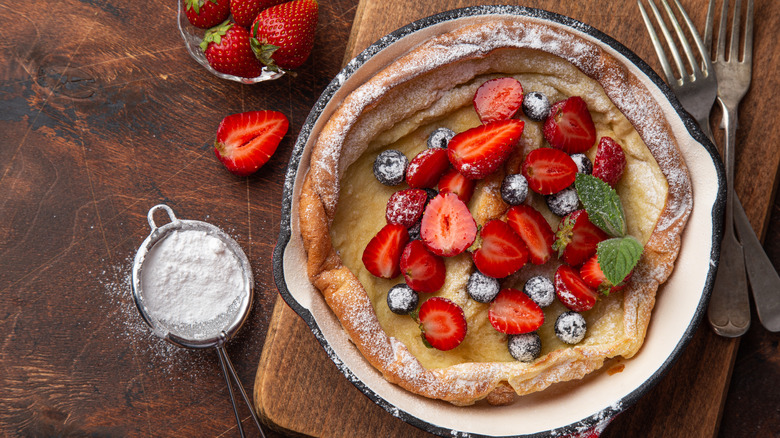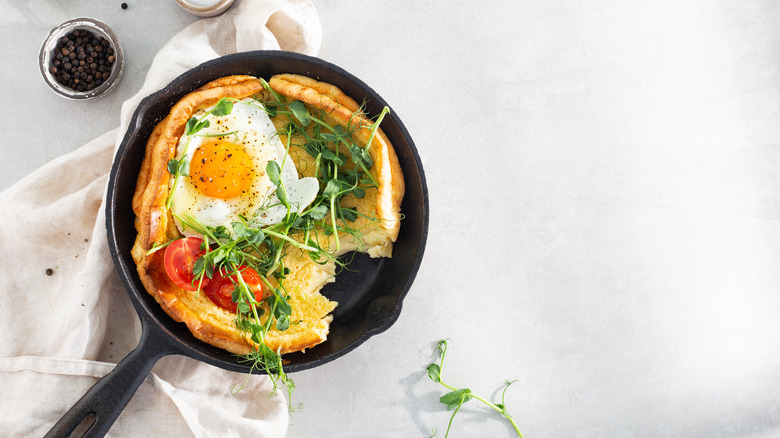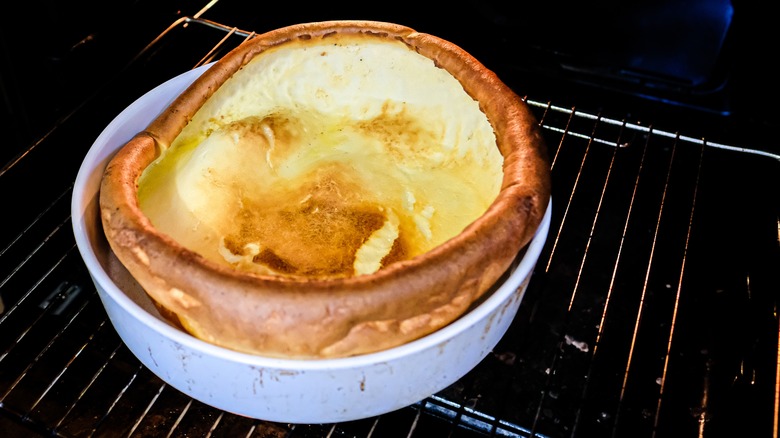The Americanized Origins Of Dutch Baby Pancakes
The term "Dutch baby pancakes" is somewhat contradictory to the dish it describes. First, these pancakes are not from the Netherlands. Second, there is nothing "babyish" about their size. And third, they don't resemble the American-style flapjacks typically thought of when hearing the term "pancakes." Yet, Dutch baby pancakes are thought to have originated in the United States.
As the story goes, in the early 1900s, a Seattle-based diner called Manca's Cafe made its pancake batter from a recipe derived from the German pfannkuchen, which are similar to crepes, but a bit eggier and thicker. For convenience, the cook baked the cakes in a pan in the oven instead of on a griddle. The pancake puffed up and rose out of the pan, resembling a popover, or a large Yorkshire pudding.
Next, the cafe owner's daughter mispronounced the word "Deutsch," which means "German," and instead called the pancakes "Dutch," thereby cementing the dish's name. They are sometimes referred to as German pancakes, even though they are very different from, and not commonly eaten in, Deutschland. Dutch babies aren't entirely unique in the culinary world; there are similar dishes like the Austrian kaiserschmarren and the Finnish pannukakku, which are both puffy, oven-baked pancakes with crisp exteriors and custard-like centers.
Customize your Dutch baby with toppings
Dutch baby pancakes are made with a simple batter consisting of eggs, milk, flour, and sugar, although savory versions omit the sugar. No leavening agents are used to make the batter puff up in the oven. Instead, the heat of the oven causes the wet batter to create and trap steam inside, leading to the pancake's rise. Like a soufflé, the pancake begins to deflate immediately after being removed from the oven.
These pancakes are often served sprinkled with powdered sugar and a squeeze of fresh lemon juice, but you can treat them like hotcakes, opting for butter and syrup, fruit jam, chocolate hazelnut spread, or any toppings you enjoy — for example, cinnamon-dusted apples top this apple Dutch baby recipe. You can also flavor the batter with spices and extracts.
If you prefer savory pancakes, Dutch babies are an excellent choice for incorporating ingredients like bacon or sausage, cheese, onions, and other vegetables, making them suitable for breakfast, brunch, lunch, or dinner. Sweet Dutch baby pancakes also make delightful desserts when topped with ice cream, which melts beautifully once placed on the pancake right out of the oven.
Getting the puff just right
Dutch baby pancakes are usually served right in the skillet they've been baked in, inspiring lots of "oohs" and "ahs" from hungry diners because the large, golden rise of the pancake can be quite impressive when prepared correctly. However, there are a couple of elements to remember if you want an impressive puff. Since the recipe doesn't involve a leavener like baking soda or baking powder, you need to ensure plenty of air is incorporated into the batter for proper steaming to occur. Whisk vigorously, or (to save yourself some arm pain) combine the ingredients in a blender or food processor. You'll also need to let the batter rest so the gluten and proteins can develop, which helps stretch and hold air.
Plenty of heat is also essential, and not just from your oven. Like popovers and Yorkshire puddings, you want your batter to sizzle immediately when it hits the pan. Therefore, while your oven is preheating, place your iron skillet inside to get hot as well, so that when you pour in your batter, steam is immediately created. Your Dutch baby should be a big, tall baby every time.



